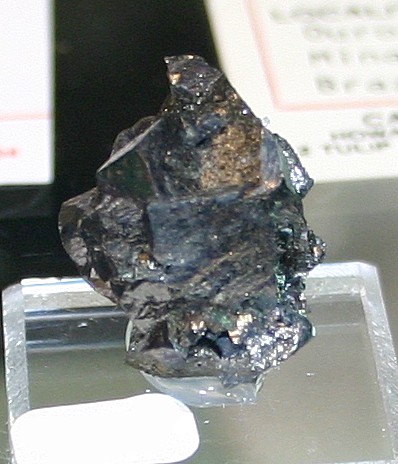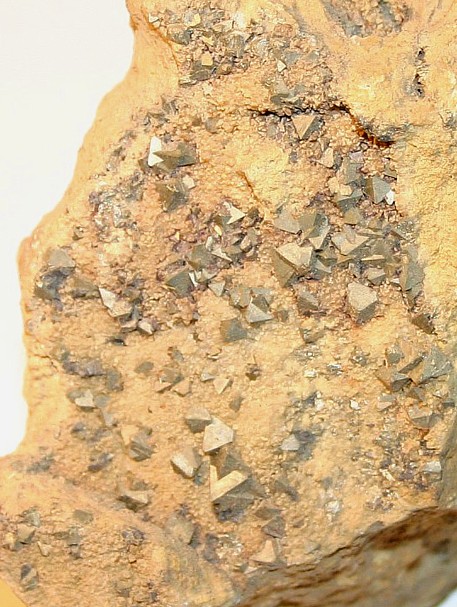|
.
Tetrahedrite
Mineral Facts:
Chemical Formula: Cu12Sb4S13
Sulfide of
copper and antimony.
Colors:
Usually steel gray to iron black.
Very thin splinters
appear cherry red by transmitted light.
Hardness:
3 to 4.5
Density:
4.6 to 5.1
Cleavage:
One poor cleavage on 0001. Fracture
is conchoidal and uneven: brittle.
Crystallography:
Isometric; tetrahedral.
The crystals of
both tetrahedrite and tennantite are tetrahedral habit, the principal forms
on them consisting of the simple tetrahedron and complex tetrahedrons
together with the dodecahedron, and the cube. Twins are common.
Luster:.
Metallic and opaque, except
on thin edges as noted.
Optics: (Refractive Index) = Opaque
|
 |
|
Composition, Structure and
Associated Minerals:
The name
tetrahedrite is given to a mixture of basic sulfantimonites and
sulfarsenites crystallizing together in isometric forms with a distinct
tetrahedral habit. The isomorphism is so complete that all gradations
between the various members of the group are frequently met with. The
arsenic-bearing member of the series is known as tennantite and the
corresponding antimony member as tetrahedrite. The latter is the more
common. Part of the copper is often replaced by iron, zinc, silver, or
mercury. Part of the antimony is often replaced by arsenic, seldom by
bismuth. It sometimes contains 30 per cent, silver in place of part of the
copper, and is then called silver bearing gray copper ore, or silver fahlerz,
but is then more of the nature of
stephanite.
Found in metallic veins usually
associated with
chalcopyrite,
pyrite,
sphalerite,
galena and various other silver,
lead and copper ores.
May carry sufficient silver to become an
important ore of that metal (the highly argentiferous variety is known as
freibergite). Tetrahedrite
appears to suffer alteration quite readily, since pseudomorphs of several
carbonates and sulfides after tetrahedrite crystals are well known.
Identification
and Diagnostics
Recognized by
its tetrahedral crystals, or when massive by its fine-grained structure and
by its gray color. The crystals of tetrahedrite are so characteristic that
there is little danger of confusing the crystallized mineral with other
minerals of the same color. The massive forms resemble most clearly
arsenopyrite, cobaltite, bournonite and
chalcocite. From these the tetrahedrites are best distinguished by their
hardness, together with their blowpipe reactions.
The two species
Tetrahedrite and Tennantite are only to be told apart by testing for the
presence of antimony and arsenic, and as both are often present in the same
specimen a quantatitive analysis
may
be necessary in order
to positively determine to which end of the series it belongs.
Occurrence,
Localities and Origins:
Tetrahedrite is an
important ore of silver. Occurs at Freiberg and other localities in Saxony;
in Bohemia and Hungary; at Guanajuato and Arizpe, Sonora, etc., Mexico; in
Peru and Chile. It is found also in British Columbia and at Broken Hill, New
South Wales. In
the United States tetrahedrite occurs at the Kellogg Mines, ten miles north
of Little Rock, Arkansas; near Central City and at Georgetown, Colorado; in
the Ruby and other mining districts in the same State; at the De Soto Mine
in Humboldt Co., it was an important ore at the Comstock Lode and other
silver deposits in Nevada. Also found at several places in Montana, Utah and
Arizona.
.Return
to the
Mineral Collectors Information Page |
 |
|



